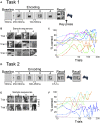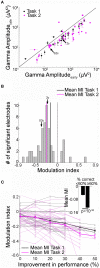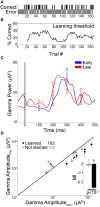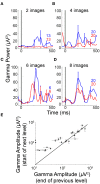Decrease in gamma-band activity tracks sequence learning
- PMID: 25653598
- PMCID: PMC4300908
- DOI: 10.3389/fnsys.2014.00222
Decrease in gamma-band activity tracks sequence learning
Abstract
Learning novel sequences constitutes an example of declarative memory formation, involving conscious recall of temporal events. Performance in sequence learning tasks improves with repetition and involves forming temporal associations over scales of seconds to minutes. To further understand the neural circuits underlying declarative sequence learning over trials, we tracked changes in intracranial field potentials (IFPs) recorded from 1142 electrodes implanted throughout temporal and frontal cortical areas in 14 human subjects, while they learned the temporal-order of multiple sequences of images over trials through repeated recall. We observed an increase in power in the gamma frequency band (30-100 Hz) in the recall phase, particularly in areas within the temporal lobe including the parahippocampal gyrus. The degree of this gamma power enhancement decreased over trials with improved sequence recall. Modulation of gamma power was directly correlated with the improvement in recall performance. When presenting new sequences, gamma power was reset to high values and decreased again after learning. These observations suggest that signals in the gamma frequency band may play a more prominent role during the early steps of the learning process rather than during the maintenance of memory traces.
Keywords: field potentials; gamma frequency oscillations; human neurophysiology; intracranial recordings; memory; sequence learning.
Figures






Similar articles
-
Neural Correlates of Music Listening and Recall in the Human Brain.J Neurosci. 2019 Oct 9;39(41):8112-8123. doi: 10.1523/JNEUROSCI.1468-18.2019. Epub 2019 Sep 9. J Neurosci. 2019. PMID: 31501297 Free PMC article.
-
Phase/amplitude reset and theta-gamma interaction in the human medial temporal lobe during a continuous word recognition memory task.Hippocampus. 2005;15(7):890-900. doi: 10.1002/hipo.20117. Hippocampus. 2005. PMID: 16114010
-
Encoding of sequence boundaries in the subthalamic nucleus of patients with Parkinson's disease.Brain. 2014 Oct;137(Pt 10):2715-30. doi: 10.1093/brain/awu191. Epub 2014 Jul 16. Brain. 2014. PMID: 25031238
-
The interaction of rhinal cortex and hippocampus in human declarative memory formation.Rev Neurosci. 2002;13(4):299-312. doi: 10.1515/revneuro.2002.13.4.299. Rev Neurosci. 2002. PMID: 12542259 Review.
-
Memory formation by neuronal synchronization.Brain Res Rev. 2006 Aug 30;52(1):170-82. doi: 10.1016/j.brainresrev.2006.01.007. Epub 2006 Mar 20. Brain Res Rev. 2006. PMID: 16545463 Review.
Cited by
-
Tracking neural correlates of successful learning over repeated sequence observations.Neuroimage. 2016 Aug 15;137:152-164. doi: 10.1016/j.neuroimage.2016.05.001. Epub 2016 May 5. Neuroimage. 2016. PMID: 27155129 Free PMC article.
-
Characterization of spatiotemporal dynamics of binary and graded tonic pain in humans using intracranial recordings.PLoS One. 2023 Oct 16;18(10):e0292808. doi: 10.1371/journal.pone.0292808. eCollection 2023. PLoS One. 2023. PMID: 37844101 Free PMC article.
-
Perspective: Phase Amplitude Coupling-Based Phase-Dependent Neuromodulation in Parkinson's Disease.Front Neurosci. 2020 Sep 29;14:558967. doi: 10.3389/fnins.2020.558967. eCollection 2020. Front Neurosci. 2020. PMID: 33132822 Free PMC article.
-
Movement-related ERS and connectivity in the gamma frequency decrease with practice.Neuroimage. 2023 Dec 15;284:120444. doi: 10.1016/j.neuroimage.2023.120444. Epub 2023 Nov 4. Neuroimage. 2023. PMID: 37926216 Free PMC article.
-
Information and the Origin of Qualia.Front Syst Neurosci. 2017 Apr 21;11:22. doi: 10.3389/fnsys.2017.00022. eCollection 2017. Front Syst Neurosci. 2017. PMID: 28484376 Free PMC article.
References
-
- Akay M. (1998). Time Frequency and Wavelets in Biomedical Signal Processing. Piscataway, NJ: IEEE Press.
Grants and funding
LinkOut - more resources
Full Text Sources
Other Literature Sources
Molecular Biology Databases

